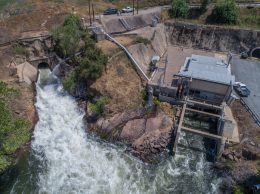Santa Maria Energy is on the hunt for private equity funding for its $120.7 million capital budget after a going-public deal fell apart.
Santa Maria Energy won approval last year to drill 136 new oil wells near Orcutt. Shortly afterward, it announced a deal that would have raised up to $79 million and taken the company public through a merger with Hyde Park Acquisition Corp. II, a so-called blank check firm.
But the deal fell through on May 2 when Hyde Park couldn’t gather shareholder support to pump at least $40 million into Santa Maria Energy, the minimum threshold for the transaction.
Santa Maria Energy said from the outset of its going-public plans that it would have also needed to tap private equity to meet its capital budget. The company will now turn to those investors.
“We knew that this was a possibility,” said Beth Marino, vice president of legal and corporate affairs for the firm. “We planned accordingly and have made plans to secure alternate financing. We’re kicking that off immediately and don’t anticipate this will cause a significant delay in our plans.”
The deal would have put Santa Maria Energy on the Nasdaq. The company has already secured $50 million in private equity funds from energy-focused Kayne Anderson Capital Advisors.
Under the deal, Hyde Park shareholders could vote to approve the transaction or ask for their money back. Hyde Park said in regulatory filings that it never took a formal vote on the Santa Maria Energy transaction because too many shareholders had requested their cash instead.
Hyde Park officials did not return a request for comment.
From the outset of the merger, Santa Maria Energy said it would have needed to raise additional capital from private equity and debt sources to fund its 2014 capital budget. Marino said Santa Maria Energy has started those talks and that changing tracks is expected to cause “some delay, but it won’t be significant.”
Bill Watkins, an economist with California Lutheran University, said a Santa Maria Energy capital investment will be “a significant and welcome addition to Santa Maria’s economy,” which has struggled with higher unemployment rates than other parts of the Tri-Counties. While some portion of the capital budget will be paid to construction contractors, many of those people will stay in Santa Maria while on the job, boosting revenue for hotels and restaurants. And once the wells are up and producing, they will create operational jobs that pay better than jobs that require similar education levels.
“In terms of returns to human capital, [oil jobs] may be the highest thing going,” Watkins said. “The only comparable thing I can think of in terms of education required is longshoremen, who are paid very well. These are not cush jobs. They may be required to be on the well site for 24 hours at a time. They may be sleeping in the truck, and they’re not at home so they’re getting paid for it.”
Watkins said that the perception that all oil jobs are for “young guys with strong backs” is no longer completely accurate. “It requires plenty of those guys, but it also uses engineers. It’s a very technological business,” Watkins said.
“I think we’ll end up with a permanent increase in the employment base, and of course the tax base goes way up.”
Oil boom
Santa Maria Energy may have enough holdings to kickstart an onshore oil boom in North Santa Barbara County all on its own. In a detailed accounting of its reserves made public for the Hyde Park transaction, the company said it believes it has about 48 million barrels of oil in reserves, worth $1.2 billion when using industry-standard discounting techniques. Only about 15.7 million barrels of that oil are what the company considers “proved” reserves, but that figure is still nearly double what the company believed it was sitting on at the end of 2012, according to company filings.
Santa Maria Energy’s most recent permit process involved drilling near Orcutt in a rock formation known as the diatomite. But the company also has acreage in the Monterey Shale formation near Orcutt, as well as thousands of potential drilling sites northwest of Casmalia and in the Santa Maria Valley. Overall the company has 15,692 net acres under lease. Santa Maria Energy’s executives believe the firm has 7,753 potential drilling locations for the future.
Bob Hatch, the CEO of the Santa Maria Chamber of Commerce, said Santa Maria Energy’s Orcutt effort is a bellwether project in a number of ways. After a lengthy permitting process with Santa Barbara County officials, the firm agreed to a 10,000-ton-per-year carbon emissions cap. The company plans to use a number of new technologies.
If the Orcutt effort is successful, it will prove that oil can be produced safely, profitably and on a large scale in a tight regulatory environment, Hatch said.
“The symbolic importance is getting this into production and showing that they are what they say they are — that they’re safe and contribute to the economy,” Hatch said. “They got pushback, but they agreed to the [carbon] threshold. Santa Maria and Orcutt, that’s the history of oil in this county. A lot of people remember that and harken back to when those were really good paying jobs and an important part of the community.”






 Print
Print Email
Email

















